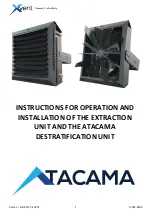
JOHNSON CONTROLS
46
FORM 102.20-OM2
ISSUE DATE: 6/01/2015
SECTION 2 - START-UP AND OPERATION
TABLE 9
- BURNER TEMPERATURE RISE (CONT'D)
CFM
TEMPERATURE RISE (°F)
INTERNAL
PRESSURE
DROP WC
DF-
175
DF-
200
17,000
95
--
0.45
18,000
90
--
0.52
19,000
85
--
0.57
20,000
81
93
0.63
21,000
77
88
0.7
22,000
74
85
0.76
23,000
71
81
0.82
24,000
68
78
0.9
26,000
62
71
1.05
28,000
58
66
1.25
30,000
54
62
1.4
32,000
51
58
1.6
34,000
48
54
1.8
35,635
45.5
52
2
DF-
225
DF-
250
DF-
275
DF-
300
24,000
87
--
--
--
0.337
27,000
77
86
92.5
--
0.427
30,000
69
77
83.3
90.8
0.527
33,000
63
70
75.8
82.5
0.637
36,000
58
64
69.5
75.7
0.758
39,000
53
59
64
70
0.89
42,000
50
55
59.5
65
1.035
45,000
46
51
55.6
60.6
1.185
48,000
43
48
52.1
55.8
1.35
51,000
41
45
50
53.5
1.525
54,000
39
43
47
50.5
1.71
58,475
35
39.5
43.5
47.5
2
DF-
325
DF-
350
DF-
375
DF-
400
31,565
95
--
--
--
0.4
35,290
85
92
--
--
0.5
41,755
72
78
83
89
0.7
47,345
64
68
73
78
0.9
52,340
57
62
66
71
1.1
54,665
55
59
64
68
1.2
59,045
51
55
59
63
1.4
63,125
48
51
55
59
1.6
66,950
45
48
52
55
1.8
70,573
42.6
45.9
49.2
52.4
2
Starting the Electric Heater
Rotating parts and electrical shock haz-
ards exist. Lock out and tag out the fan
motor(s) and heat power disconnects be-
fore servicing. FOLLOW THE LATEST
“LOCKOUT TAGOUT” PROCEDURE.
Failure to follow proper safety precau-
tions may result in serious injury or death.
Application Information
1. Follow the procedure given in this instruction to
find the minimum air velocity for safe operation
(see Fig. 1). At least this minimum velocity must
be provided at all points over the heater face area.
Failure to meet this requirement may result in se-
rious damage or nuisance thermal cutout tripping.
2. The maximum air inlet temperature for open coil
heaters is 100°F, and for finned tubular heaters,
80°F.
3.
Sufficient working space must be provided per
paragraph 110-26 of the National Electrical Code
(NEC).
4. This electric heater is not designed for or intend-
ed to be used for temporary heat prior to system
startup / balancing.
Mechanical Installation
1.
All heaters will contain an adjustable airflow
switch in the heater control panel. This switch
will be preset to close at a differential pressure of
approximately 0.3" W.C. In all cases the switch
will be connected to a pressure probe positioned
in the airstream. This probe has an arrow stamped
on it that is viewable from inside of the control
panel. When the heater is located upstream of the
fan this arrow will point away from the fan. When
the heater is located on the downstream side of
the fan the arrow will again point away from the
fan or with airflow. If it is incorrectly installed,
remove the two screws holding the pressure probe
in place and rotate 180° and reinstall. The airflow
switch pressure port that is not connected to this
pressure probe will be run to the exterior of the
air handling unit to source a reference differential
pressure. In some situations it may be necessary
to adjust this airflow switch setting to allow for
proper operation. Precautions must be made at
this time to make sure that the airflow switch does
not provide a false indication of airflow. Failure to
meet this requirement may result in serious dam-




































